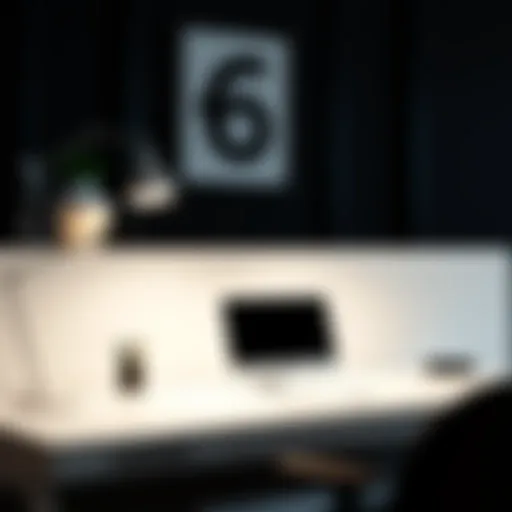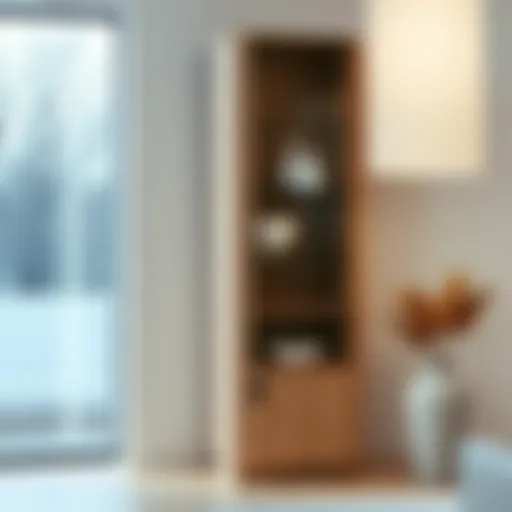The Artful Integration of Glass in Liquor Cabinets
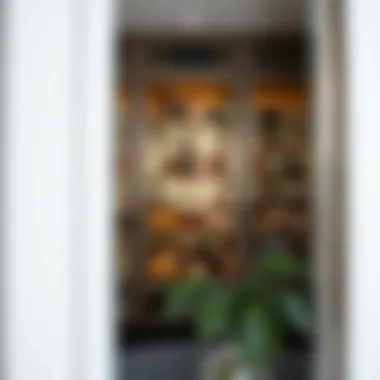

Intro
In the realm of interior design, the role of materials is paramount. Among them, glass emerges not merely as a functional element but as a beacon of elegance. The inclusion of glass in liquor cabinets transforms both the aesthetic and practical aspects of the furniture. It allows for a glimpse of the fine spirits within while also serving to elevate the overall ambiance of the space. The fascinating interplay between glass and other materials invites homeowners, designers, and DIY enthusiasts to reflect on their choices deeply, revealing layers of meaning hidden in modern styles.
Furniture Design Trends
Current Styles and Aesthetics
Glass in liquor cabinets has evolved significantly from merely serving as a barrier to encompassing a wide range of styles. Contemporary designs often favor minimalism, where sleek glass doors highlight the spirits and enable light to dance through the shelves. Think of a high-gloss white cabinet with transparent glass doors—this configuration reflects simplicity and sophistication in equal measure. However, the charm doesn't end there.
On the other end of the spectrum, some designs capture the warmth of the industrial vibe with heavy glass and wooden elements, breaking away from starkness. This juxtaposition nurtures an inviting atmosphere, reminiscent of a classically rustic home bar.
For instance, a cabinet featuring reclaimed wood alongside frosted glass can stir nostalgia while being firmly planted in modern design. Each choice reflects not just personal taste but also a story waiting to be told.
Color Palettes and Materials
When discussing color palettes, the versatility of glass comes to light. Clear glass is often a favorite, providing adaptability through various decors. Yet, colored glass or tinted variations can add unexpected flair. A liquor cabinet featuring emerald green glass doors makes a bold statement while seamlessly integrating into a chic or eclectic space.
Moreover, the materials surrounding the glass play a substantial role in overall aesthetics. Combining materials raises the visual stakes: brass handles, for instance, strikingly contrast with the smooth coldness of glass, blending industrial chic with opulence. Additionally, the interplay of textures—think glass juxtaposed with smooth marble or rough-hewn wood—creates depth and intrigue.
Buying Guides
Essential Considerations When Purchasing
When navigating the market for the perfect liquor cabinet, several factors ought to be considered:
- Size: Assess the space available for installation. Your cabinet should fit comfortably without overwhelming the room.
- Storage Needs: Consider how you plan to use it; do you need built-in wine racks or additional compartments for glassware?
- Glass Quality: Ensure the glass is durable enough to handle wear and tear. Tempered glass is a practical choice to avoid hazards.
- Overall Style: Align your choice with existing decor. The cabinet should harmonize with your home’s design language, be it modern, rustic, or classic.
Top Recommendations for Different Budgets
When looking to invest in a liquor cabinet, it's vital to find options suitable for various budgets:
- Budget-Friendly:
- Mid-Range:
- Luxury:
- IKEA's MIKADON offers a clean design with tempered glass shelves, perfect for those starting a collection.
- The West Elm Mid-Century Bar Cabinet combines elegance with functionality, featuring walnut and glass for a polished finish.
- A bespoke option from Poltrona Frau stands out, blending Italian craftsmanship with custom glass solutions that ooze style.
In summary, as glass continues to captivate hearts and minds in liquor cabinet design, its role becomes undeniably significant, influencing styles, functions, and even the emotional resonance of interior spaces. Selecting the right piece requires thoughtful consideration, ensuring it resonates with your personal aesthetic while embodying the spirit of craftsmanship.
Foreword to Liquor Cabinets and Glass Designs
The charm of liquor cabinets has evolved from simple storage solutions to key design elements within our living spaces. In this journey, glass plays a central role—elevating both functionality and aesthetic appeal. The delicate balance of transparency and sturdiness makes glass an ideal choice in liquor cabinet design, allowing for an open display of curated spirits while safeguarding them from dust and accidents.
When we think about a home bar, the cabinet is more than a place to stash drinks—it’s a statement piece. Integrating glass into these designs not only enhances visibility but also reflects personal style. With options ranging from pristine clear glass to sophisticated frosted types, homeowners have a diverse palette from which to express themselves.
In addition to flair, there are practical considerations involved in the use of glass. Safety standards, maintenance needs, and structural support are all critical aspects that one must consider. In the world of liquor cabinets, understanding these elements is paramount not only for the beauty of the design but also for its durability.
Significance of Liquor Cabinets in Home Decor
Liquor cabinets often occupy a spotlight in home spaces. They can easily become a focal point in a dining room, living room, or even a dedicated bar area. Cabinets made of exquisite wood or metal certainly grab attention, but when glass is added, the contrast creates a sophisticated allure.
Having a well-designed liquor cabinet can facilitate social interactions and provide an inviting atmosphere for gatherings. It encapsulates a sense of hospitality, showing that the space is ready for good times. Moreover, these cabinets can reflect personal tastes—from ultra-modern to vintage chic—thereby fitting seamlessly into an array of home decor styles.
Some may say that liquor cabinets serve more than just the purpose of storing bottles; they are conversation starters. Guests will find themselves drawn to admire the collection, and the craftsmanship of the cabinet itself. A glass-fronted cabinet, in particular, offers a view of the drinks while allowing light to penetrate beautifully, enhancing the overall ambiance of the room.
Historical Overview of Liquor Cabinets
The concept of liquor cabinets dates back centuries, originating in the 17th century when they were often constructed as elaborate furniture pieces designed not only for practicality but also for artistry. Early on, these cabinets were heavy and ornate, made from solid wood, showcasing intricate carvings and inlays.
As the centuries rolled on, design philosophies shifted along with societal norms. By the 19th century, the advent of glass allowed for the creation of more refined designs. Glass made it possible to include illuminated cases that proudly displayed the selection of spirits, elevating the experience of both the owner and their guests.
In modern times, as the art of mixology gained momentum, liquor cabinets have transitioned into stylish furniture that can accommodate a wide variety of bottles and even glassware. Contemporary designs often balance elegance with minimalism.
A little known fact is that glass elements became more commonly accepted during the industrial revolution, which made glass production less expensive and more accessible to the everyday consumer. This democratization allowed the luxuries once reserved for aristocrats to filter down into more moderate homes, fundamentally altering the way people perceived home bars and liquor storage.
Types of Glass Used in Liquor Cabinets
When it comes to liquor cabinets, the selection of glass is not just about aesthetics; it plays a vital role in durability, visibility, and overall design appeal. Choosing the right type of glass can transform a seemingly ordinary cabinet into a functional and striking piece of furniture. There are various types of glass, each with its unique characteristics, advantages, and potential drawbacks to consider. This section will explore tempered glass, frosted glass, and clear glass—delving into their distinct features and benefits in the context of liquor cabinet design.
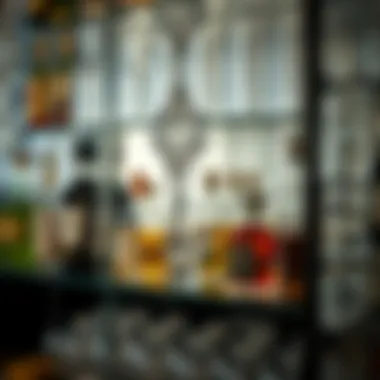

Tempered Glass
Tempered glass is a go-to choice for many liquor cabinet designs due to its exceptional strength and safety features. It is created through a process of extreme heating and rapid cooling, making it much tougher than regular glass. This durability means that it is less likely to shatter, a crucial factor for homeowners who want to ensure their cabinet is secure, especially in busy entertainment spaces. If you have kids running around, the incorporation of tempered glass is a smart move.
One significant benefit of tempered glass is its resistance to thermal stress. This means that if you’ve just poured a steaming drink or opened a bottle at room temperature, the glass maintains its integrity without the risk of cracking from sudden temperature changes. Additionally, tempered glass can be treated to enhance its aesthetic value, such as applying a tint or even a subtle etch, allowing for that perfect blend of safety and style.
Frosted Glass
Frosted glass serves as an alluring middle ground between privacy and visibility, which can be quite appealing for liquor cabinets. The frosted surface diffuses light, making the contents inside less visible while still adding an ethereal quality to the overall design. Is your cabinet stocked with a collection of expensive spirits? Frosted glass can give it an air of sophistication while providing a bit of secrecy around what exactly is stored within.
Another compelling aspect of frosted glass is its ability to hide fingerprints and smudges. Unlike clear glass, which can require constant cleaning to maintain a pristine look, a frosted surface naturally camouflages everyday grime. This makes maintaining your liquor cabinet easier, allowing more time for you to enjoy your favorite spirits rather than worrying about upkeep. ❄️
Clear Glass
Clear glass is the classic choice that has adorned liquor cabinets for generations. This timeless option allows for a full view of the displayed bottles and glassware, exhibiting them like trophies on a pedestal. If you have a curated collection of vintage whiskeys or a colorful array of liqueurs, clear glass gives them the attention they deserve. The transparency can create a sense of openness in the room, making it ideal for smaller spaces where you want to achieve a feeling of lightness.
However, it’s wise to consider the care that clear glass necessitates. It shows dust and fingerprints more readily than its frosted counterparts. Regular cleaning becomes essential to keep its clarity intact, a small price to pay for the beauty it offers. You might even find that the effort enhances the experience of showcasing your collection; the ritual of maintaining the display fosters a stronger connection to your items.
"The type of glass you choose can either enhance or diminish the aesthetic of your liquor cabinet. A careful selection ensures your collection shines just as brightly as the finest spirits it holds."
In summary, the types of glass used in liquor cabinets—tempered, frosted, and clear—each offer unique advantages that cater to different homeowner preferences and lifestyles. Understanding their properties and implications can lead to better design choices, ultimately elevating the elegance of your liquor cabinet while maintaining safety and functionality.
The Aesthetic Appeal of Glass in Cabinet Design
The role of glass in liquor cabinets transcends the mere functionality of storage; it significantly enhances the aesthetic quality of the entire piece. Glass not only provides a window into your curated collection of spirits but also reflects the style and sophistication of your home. With its transparency and reflective properties, glass can effortlessly elevate a cabinet from a simple storage unit to a stunning focal point in any room. By choosing the right type of glass, homeowners and designers can create an impact that resonates with their personal tastes and harmonizes with other design elements.
"A well-designed liquor cabinet not only holds your favorite spirits but also tells the story of your tastes and style."
Enhancing Visibility of Liquor Collections
When it comes to showcasing your liquor collection, visibility is key. Glass, especially when used in liquor cabinets, aids in displaying bottles, glasses, and accessories in an appealing manner. The clarity of tempered or clear glass means that visitors don’t have to dig around or open doors to appreciate what’s inside. Instead, they can enjoy a visual feast right at first glance.
- Maximized Exposure: An effortlessly organized collection can draw attention and admiration from guests, making the cabinet a conversation starter.
- Styling Options: With clear glass, perhaps accented by integrated LED lighting, you can highlight specific bottles or glassware, creating a sophisticated ambiance while keeping the liquor itself illuminated in a visually pleasing way.
- Showcasing Colors and Labels: Many liquors come in eye-catching bottles, and exposing these vibrant colors and unique labels can add character to the decor while also drawing interest.
Using glass to enhance visibility also calls for careful consideration regarding organization. A well-arranged display not only looks great but also ensures that your cherished selections are easily accessible, allowing for an effortless pouring experience.
Creating a Sleek, Modern Look
A key attraction of glass in cabinet design is its ability to instill a modern and minimalist aesthetic within a space. It melds seamlessly with contemporary themes, reflecting a sleek and sophisticated style that appeals to many homeowners and designers.
- Clean Lines and Minimalist Approach: Transparent glass brings a sense of openness to bottled spirits, avoiding the cluttered feel often associated with wooden cabinets. This design philosophy embraces simplicity, using less visual weight while still making a striking statement.
- Texture and Light Play: Glass can interact uniquely with light, creating dynamic reflections and an atmosphere that fluctuates with the time of day. The ability of glass to refract light adds layers to interior design that wooden cabinets simply can’t achieve alone.
- Integration with Other Materials: Combining glass with metal frames or wooden shelves introduces contrast while maintaining a harmonious balance. This layering of materials showcases dedication to both function and form, enhancing the overall visual interest of the piece.
In summary, the aesthetic appeal of glass in cabinet design lies not just in its beauty but also in its versatility and ability to elevate the liquor cabinet to a visual centerpiece. When well-executed, it complements both modern and traditional styles, proving that glass is not only a practical choice but a truly elegant one.
Practical Considerations for Glass Usage
When it comes to liquor cabinets, the inclusion of glass elements brings not only visual appeal but also practical aspects that cannot be overlooked. Understanding how glass interacts with the nuances of cabinet design is crucial for homeowners and designers alike. Making well-informed decisions on weight, durability, maintenance, and safety can mean the difference between a striking showcase and a regrettable mishap.
Weight and Durability Factors
One significant aspect concerning the use of glass in liquor cabinets is its weight and durability. While glass may give an airy appearance to a cabinet, it can actually be considerably heavy, especially when dealing with thicker panes. This leads us to evaluate what materials can adequately support this weight.
- Choosing the Right Thickness: For cabinets that are meant to hold a sizable collection of spirits, thicker glass—ranging from 6mm to 12mm—should be factored in. This choice contributes to both strength and aesthetics. Too thin a pane might bow under pressure or even crack, turning style into disaster.
- Framework Support: Glass will typically require a sturdy frame or an appropriate mounting system to ensure it is secure. Whether it’s wood or metal, it needs to withstand the strain while offering adequate support without compromising the elegance of the design.
In essence, when considering the weight and durability factors of glass, the combination of thickness and quality framing is essential for longevity and functionality.
Maintenance and Cleaning Techniques
Cleaning and maintaining glass surfaces might seem straightforward; however, in the realm of high-style liquor cabinets, it necessitates a careful approach to preserve that pristine look. Here are several techniques and tips that can come in handy:
- Gentle Cleaners: Using harsh chemicals can be detrimental. Instead, opt for a mild glass cleaner or a homemade solution with water and vinegar. This keeps the glass clear without risking scratches or damage.
- Soft Cloths: Always use soft, lint-free cloths. Microfiber cloths are often recommended as they can effortlessly lift dust without leaving behind residue.
- Avoiding Streaks: To avoid unsightly streaks, clean the glass in circular motions, starting from one corner of the pane and moving to the opposite end. This not only provides even cleaning but also helps identify spots that may require additional attention.
- Routine Maintenance: Implementing a regular cleaning schedule will keep the cabinet looking its best. Dust and fingerprints tend to build up, particularly in high-traffic areas, and are more perceptible on glass.
Tip: It might also be worth looking into specialized glass cleaning products geared towards anti-static properties to reduce dust attraction over time.
For more on the optimal materials and cleaning strategies, check out resources at Wikipedia, or you can engage with forums like Reddit for real-world experiences shared by other homeowners.
Combining Glass with Other Materials
Incorporating glass into liquor cabinet designs isn’t just about aesthetics; it’s also about creating a harmonious balance with other materials. Each material brings its own texture, color, and style, weaving together a narrative that defines the overall look of a home bar. Understanding these combinations can help homeowners and designers make more informed choices, enhancing both visual appeal and functional quality.
Wood and Glass Combinations
The marriage of wood and glass creates a stunning visual interplay in liquor cabinets. Wood, with its warm hues and natural grains, perfectly complements the transparency of glass. This combination can evoke a rustic charm or a modern elegance, depending on the finish and design.
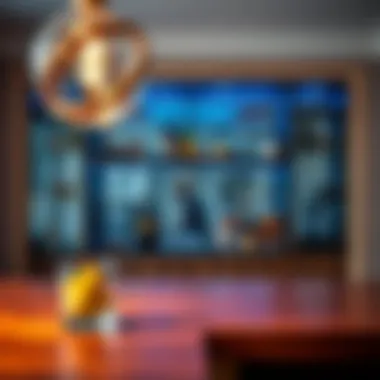

Benefits of Wood and Glass Combinations:
- Timeless Appeal: Wood has a classic essence that's enduring and versatile. Pairing it with glass can bring a contemporary twist, breathing new life into traditional styles.
- Sturdy Structure: Solid wood provides a strong frame that can withstand the weight of glass panels, ensuring durability in your liquor cabinet setup.
- Customization Options: Homeowners can choose from various wood types—like oak, walnut, or maple— to match or contrast with their interior decor.
Moreover, incorporating glass shelves into a wooden cabinet allows for an unobstructed view of the liquor collection, showcasing bottles and glassware as art pieces. A well-designed cabinet with wood and glass can also imbue depth into the space, making it feel more inviting.
Metal Frameworks for Structural Support
Metal frameworks offer a sleek, industrial vibe when combined with glass in liquor cabinets. Steel or aluminum supports are not just for aesthetic purposes; they also enhance the structural integrity of the cabinet, preventing warping or sagging over time.
When integrating metal into your design, consider the following:
- Strength and Stability: Metal offers remarkable strength-to-weight ratios, enabling the creation of larger glass panels without compromising durability.
- Modern Design Aesthetic: The use of metal can create a contemporary feel, especially with finishes like brushed nickel or anodized aluminum, appealing to those with a penchant for modern or minimalist decor.
- Versatility: Metal can be shaped and molded into various designs and styles, allowing for unique housing solutions that stand out in any room.
Combining glass with metal can create a striking contrast that resonates with urban living environments or trendy homes. It highlights the innovation in materials and illustrates how traditional designs can be stripped down to their essential elements in more modern contexts.
"The beauty of combining materials lies in the narrative they create in space, unfolding from the choices we make in design."
By thoughtfully integrating glass with wood and metal, designers and homeowners can develop liquor cabinets that serve as not only practical storage solutions but also striking focal points in interior spaces.
Customizing Glass in Liquor Cabinets
Importance of Customizing Glass in Liquor Cabinets
When it comes to liquor cabinets, glass is not just about protection; it’s a canvas for creativity. Customizing glass in liquor cabinets elevates both style and functionality, allowing homeowners to express their personal flair while serving a practical purpose. The adaptability of glass offers unique opportunities that go beyond mere aesthetics. Customization can enrich the visual appeal, enhance the overall user experience, and harmonize with existing decor—important factors for anyone looking to make a statement in their home.
Personalized Glass Etching Options
Personalized glass etching options bring a touch of elegance that's tough to beat. With etching, homeowners can carve out initials, significant dates, or even intricate designs onto the glass surface. This not only offers a distinctive look but makes the liquor cabinet a unique focal point. Imagine showcasing a grand selection of spirits behind a beautifully etched glass door; it’s not just storage, it's art in motion. Custom etching can serve as a conversation starter during gatherings by lending a personal touch that tells a story.
Considerations for Personalized Etching:
- Design Complexity: Simpler designs are more cost-effective and less time-consuming.
- Legibility: Keep in mind the size and placement of etchings for maximum visibility.
- Durability: Choose proper materials that will endure over time; clarity and wear resistance matter.
“The beauty of etching lies in its ability to transform something ordinary into something remarkable.”
Color Choices and Tints
Color choices and tints in glass can dramatically alter the vibe of any liquor cabinet. Whether you're aiming for a bold statement with tinted shades or a subtler hue that integrates seamlessly into the decor, customizing the color of the glass allows homeowners to manipulate light and mood effectively. Tinted glass can enhance overall aesthetics while providing added privacy, making it an appealing option for those who desire a little mystique in their home bar setup.
Popular Tint Options Include:
- Smoked Glass: This trendy dark shade offers a sophisticated and modern look.
- Frosted Tints: Provides a soft appearance while hiding the contents; suitable for a minimalist approach.
- Colored Glass: Bright, vibrant colors add fun and personality, ideal for cheerful or eclectic designs.
Utilizing tints not only improves aesthetics but can impact how light interacts with the space. For instance, a deep green or cobalt blue glass can give off a calming vibe, integral for a relaxation area in the home. Choosing the right colors can not only reflect personal style but also create the perfect atmosphere for unwinding with a glass in hand.
By focusing on customization through aspects like etching and color, liquor cabinets can become more than just functional storage; they morph into personalized expressions of art and individuality—creating a space that’s uniquely yours.
Glass Safety Features
When integrating glass into liquor cabinets, safety becomes a paramount concern. This section dives into the essential elements surrounding glass safety features, ensuring not only an elegant aesthetic but also peace of mind—for homeowners, designers, and DIY enthusiasts alike. With the correct safety measures, glass can be a stunning yet secure component of any cabinetry.
Understanding Safety Glass Standards
Safety glass standards are crucial to managing risks associated with glass use. These standards dictate how glass is manufactured and tested for safety, providing guidelines that ensure durability and minimize injury risks. Many homeowners might not realize that not all glass is created equal.
- Tempered Glass: This type of glass is treated by heating and cooling, which enhances its strength, making it less likely to shatter on impact. If broken, it crumbles into tiny, blunt pieces rather than sharp shards.
- Laminated Glass: Often used for windows, this type comprises two or more layers of glass bonded together with an interlayer, which holds the glass in place if it shatters.
- Standard Float Glass: While less expensive, standard float glass lacks the strength of tempered or laminated types, making it a less safe choice for liquor cabinets that could see various levels of impact.
Adhering to these standards not only protects the items displayed within the cabinet but also enhances the longevity of the furniture itself. For more detailed standards, resources like ASTM International might be useful.
Impact Resistance in Liquor Cabinets
Impact resistance is another critical aspect to consider. With the potential for accidents—think of a misplaced elbow or a boisterous gathering—understanding how glass withstands impact can prevent disasters. Nobody wants to deal with a cabinet full of shattered glass and splintered spirits.
When selecting glass for liquor cabinets, consider the following:
- Evaluating Thickness: Thicker glass panels generally offer higher impact resistance. Opt for at least 6mm thick tempered glass for optimal safety.
- Reinforced Designs: Whether through a metal frame or strategic bracing, adding structural support to glass panels dramatically enhances their resilience.
- Strategic Placement: Installing glass in less trafficked areas or as sliding doors reduces the likelihood of impact, preserving both the glass and the beautiful liquor collection.
"The safety of glass structures combines functional design with art. The cabinet should not only showcase fine liquors but also prioritize protection against unexpected events."
Emphasizing safety features must blend seamlessly into the overall design. When engaging with materials, it is wise to consult with a professional who understands both aesthetic and structural needs.
In summary, addressing glass safety features is indispensable when designing your liquor cabinet. By selecting the right type of glass while prioritizing functional standards and impact resistance, homeowners can enjoy the elegance of glass without compromise.

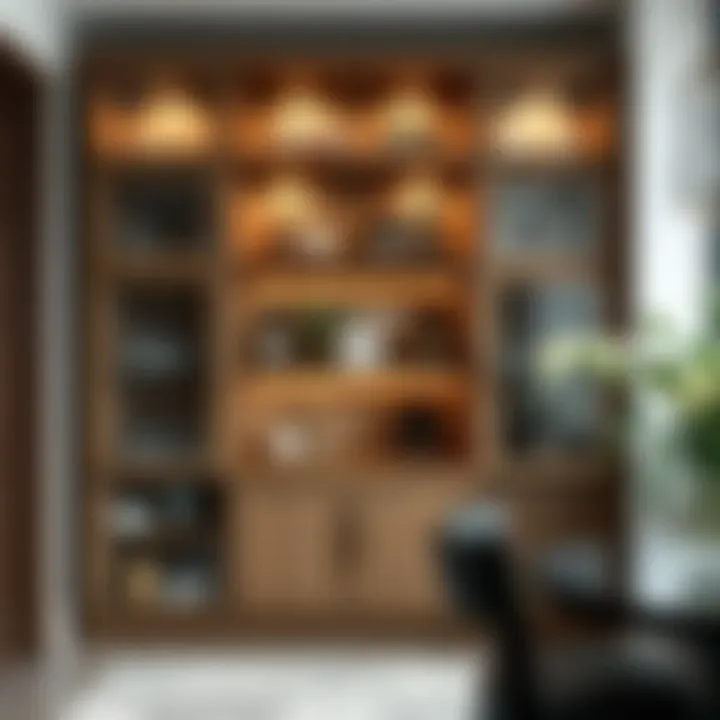
The Role of Lighting with Glass Cabinets
Lighting plays a pivotal role in the design and functionality of glass liquor cabinets. A well-thought-out lighting scheme not only enhances the visual appeal of the cabinet but also elevates the entire bar experience. When glass surfaces are combined with effective lighting, the result can be stunning. This section delves into the merits of integrating lighting into liquor cabinets, focusing on specific elements and benefits while considering what is essential for achieving that perfect ambiance.
A liquor cabinet, done right, showcases prized bottles and glassware like a museum exhibit. But without proper lighting, even the most luxurious designs can fall flat. Selecting and implementing the right lighting is crucial in highlighting the cabinet’s features, creating depth, and ensuring that everything is visible and inviting.
"Good design is all about good lighting; it can transform any space into an enchanting atmosphere."
Utilizing LED Lighting for Displays
LED lighting has become a go-to choice when it comes to illuminating glass liquor cabinets. What makes LEDs so appealing? For starters, they are energy-efficient and come in a variety of colors and intensities. Homeowners and designers can choose cool, crisp whites or warm, inviting hues according to the mood they want to evoke.
- Energy efficiency: LEDs consume less power compared to traditional bulbs. This means that they can shine bright without risking a spike in the electricity bill.
- Longevity: LEDs have a long lifespan, so replacements are infrequent. This saves money and reduces waste – a solid choice for eco-conscious buyers.
- Flexibility: Modern LED strips can be bent and placed in various locations, allowing for creative installations within the cabinet.
Using cool white LEDs can give a sleek, modern vibe, perfect for contemporary designs, while warmer tones may complement vintage cabinets beautifully. Furthermore, since these lights emit minimal heat, you avoid potential damage to the liquids and glasses stored within. For a refined look, consider recessed LED lights in shelves; they blend seamlessly into the structure and provide an ethereal glow.
Creating Ambiance through Backlighting
Backlighting enhances the drama of glass cabinets, transforming them into focal points of an interior space. When bottles and glassware are subtly illuminated from behind, they glow with a captivating radiance that draws the eye and creates a cozy atmosphere.
Some key considerations for backlighting include:
- Placement: The positioning of backlights can significantly affect how the items are displayed. Horizontal strips behind bottles help them look their best, while vertically-installed lights can accentuate the height of the cabinet.
- Dimmer Switches: Installing dimmers allows homeowners to personalize brightness according to the occasion, from a lively gathering to a quiet evening.
- Layering: Combining backlighting with overhead or shelf lights adds dimension to the display. This layering technique brings depth and richness to the bar area while allowing guests to appreciate the allure of the collection.
Using backlighting effectively can transform an ordinary liquor cabinet into an extraordinary centerpiece that adds warmth and character to the home. The right lighting not only showcases the beauty of the glass but also invites appreciation of the carefully curated selection within.
Sustainability and Eco-Friendly Options
In today's world, where environmental concerns are more pressing than ever, the importance of sustainability and eco-friendly practices in home design cannot be overstated. Glass, often overlooked for its ecological impact, plays an integral role in creating liquor cabinets that not only exude elegance but also adhere to principles of environmental responsibility. Selecting materials that minimize harm to our planet is crucial, and glass fits this bill in several ways, particularly due to its recyclability and the potential for sourcing it responsibly.
The benefits of opting for eco-friendly glass in liquor cabinet design extend beyond mere aesthetics. By choosing sustainable glass options, homeowners and designers contribute to a reduction in landfill waste, promote energy conservation during production, and often achieve more durable finishes that stand the test of time. These aspects align with a growing awareness among consumers regarding their environmental footprint, which is increasingly influencing purchasing decisions.
Another critical consideration is the lifecycle of the materials being used. Designers and DIY enthusiasts alike can facilitate an eco-conscious environment by opting for glass that is not only sourced sustainably but also designed to last. The durability of quality glass ensures less frequent replacements, which directly impacts resource consumption.
"Choosing eco-friendly materials is not just a trend; it’s a commitment to future generations, ensuring that elegant design does not come at the expense of our planet."
Recycled Glass Possibilities
Recycled glass opens a treasure trove of possibilities for creating stunning liquor cabinets that showcase both elegance and sustainability. This type of glass often comes from post-consumer products, meaning that it has been repurposed from items like bottles or windows, and is then reprocessed into new products. Utilizing recycled glass minimizes the demand for virgin materials and significantly reduces energy consumption during the manufacturing process.
When designing liquor cabinets, incorporating recycled glass can also add a unique character to the piece. Each cabinet becomes a testament to artistry and sustainability. Here are some notable points regarding recycled glass:
- Unique Aesthetics: Recycled glass often features color variations and textures that add an artisanal flair.
- Environmental Impact: Using recycled glass lessens the need for new materials, conserving resources and reducing landfill waste.
- Cost Effectiveness: It can sometimes be less expensive than brand-new, premium glass while still providing a high-quality appearance.
Sourcing Environmentally Responsible Materials
Sourcing environmentally responsible materials is a pivotal step in creating liquor cabinets that resonate with eco-conscious designs. Selecting suppliers who prioritize sustainability involves looking into their production methods, waste management, and their commitment to minimizing environmental harm. This practice not only ensures a lower ecological footprint but also resonates with a clientele increasingly concerned about sustainability.
When looking for suppliers, consider the following:
- Certifications: Seek out companies with environmental certifications that demonstrate a commitment to sustainable practices.
- Transparency: Choose manufacturers who are open about their sourcing and production processes.
- Local Sourcing: Whenever possible, finding local suppliers reduces transportation emissions and supports local economies.
Moreover, engaging with eco-friendly materials extends beyond glass. The framework and complementary materials in liquor cabinets, such as sustainably sourced wood or recycled metal, can further enhance the cabinet's environmental responsibility. By fusing elements that are both stylish and sustainable, homeowners can create a coherent design that aligns with modern values while still being aesthetically pleasing.
Future Trends in Glass Liquor Cabinet Design
As homeowners and designers continue to seek out the intersection of functionality and style, the future of glass liquor cabinets holds promising developments. Artful design paired with innovative technology reflects an evolution that caters to contemporary tastes and practical needs. The importance of exploring these future trends lies in understanding how they can enhance usability, aesthetics, and sustainability in home interior spaces.
An essential element is the integration of smart technology into designs. This trend enables homeowners and designers to control lighting, temperature, and even inventory management from the palm of their hand. Imagine a liquor cabinet that tells you when you’re running low on a specific bottle or allows you to set mood lighting for when you’re drafting cocktails for guests. Such features not only add convenience but also push the boundaries of traditional cabinet designs.
Moreover, the quality of glass is continuously improving, adhering to the expectations of a discerning audience. Self-cleaning glass, which resists fingerprints and smudges, for instance, resonates well with those who value minimal maintenance. Such innovations are crucial, especially in high-traffic areas where liquor cabinets often become focal points at gatherings or casual get-togethers.
Innovations in Glass Technology
When discussing innovations in glass technology, it’s impossible to overlook advancements such as laminated and tinted glass. Laminated glass, which sandwiches a layer of PVB (Polyvinyl Butyral) between two sheets, enhances safety while allowing for creative expression in color. As a result, this glass type can be custom-made to achieve stunning visual effects that fit perfectly into any decor style. The added strength provides a layer of safety that can be particularly reassuring in homes with children or pets.
Tinted glass is quickly becoming a go-to option, providing both aesthetics and functionality. Light-absorbing coatings can be added to the glass to reduce glare while simultaneously creating a lavish look. Homeowners can select a tint that complements their existing decor, adding a touch of luxury without sacrificing visibility.
Apart from aesthetics, energy-efficient glass products are emerging, which can help regulate temperature and reduce energy costs. These advancements lend themselves well in diverse climates, ensuring that liquors remain at optimal serving temperatures and minimizing the risk of spoilage.
Emerging Design Aesthetics
Emerging design aesthetics reveal a shift towards minimalist and industrial styles. Glass is at the forefront of this movement, serving as a medium that balances openness with elegance. Clean lines, paired with sleek glass shelves, are a hallmark of modern liquor cabinet design, appealing to the taste of homeowners who appreciate simplicity without compromising on quality.
A notable aesthetic is the juxtaposition of glass with organic materials, such as reclaimed wood or stone. This combination not only emphasizes the natural beauty of each material but creates a warm and inviting environment. The transparency of glass can showcase the craftsmanship of wooden elements, allowing for an interplay that tells a story through the design.
With sustainability soaring to the top of many consumers' priority lists, eco-friendly glass options are also on the rise. From using recycled glass to sourcing from responsible suppliers, these choices cater to a conscientious audience dedicated to preserving our environment.
Homeowners and designers alike should be attuned to these trends, which are reshaping the landscape of liquor cabinets. Every piece not only serves a practical function but contributes to the overall narrative within the space it occupies. The future is not just about storing spirits; it is about creating an experience that resonates with comfort and style.





